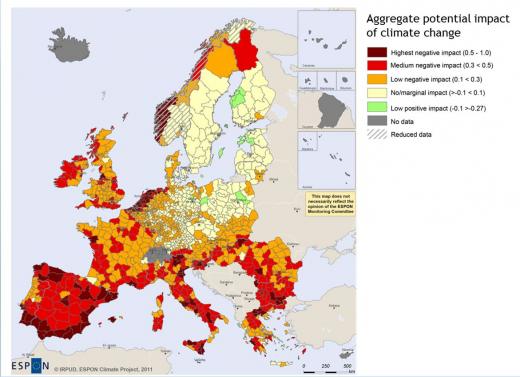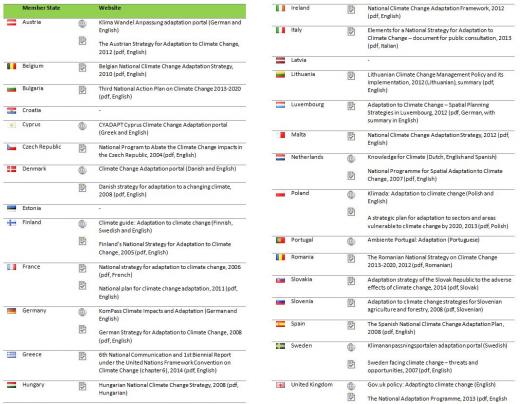Issues:
Keywords:
1. Changing climate in Europe requires adaptation measures
Climate change has already become significant in Europe, with the mean temperature increasing, and extreme weather events becoming more frequent. The average temperature of the European land area was 1.3 °C higher in the decade from 2002 to 2011 than before the industrial revolution. Regarding specific events, while extremes of cold have become sporadic throughout Europe, extremes of heat have become more frequent. The average length as well as frequency of summer heat waves has increased. In addition, although there are no significant changes in average precipitation, heavy rainfall events are becoming more regular in most parts of Europe.
The European Environment Agency (EEA) has analysed the impacts that climate change already has, and is expected to have in the near future, on the European environmental systems and the society, and it has published an overview. Effects are widespread and diverse.1 The following section provides a synopsis of different areas in which climate change can have an effect in Europe:
- Floods and droughts: Sea-level rise and changes in the intensity and frequency of storm surges have major impacts on low-lying coastal areas. Around 200 million people live in European coastal zones that are at risk of flooding. Climate change also leads to strong changes in the seasonality of river flows. This does not only lead to an increasing frequency of river floods, but also to major droughts.
- Oceans: Marine ecosystems are affected by ocean acidification and the increase of sea surface temperatures. Almost one-fifth of habitats and 12% of species in Europe are potentially threatened by climate change in this manner.
- Agriculture and fisheries: Heat waves and droughts greatly reduce the yields of some crops, especially in Central and Southern Europe. In Northern Europe the suitability for growing certain crops is projected to improve as a result of climate change. Ocean warming will lead to shifting geographical distributions of wild fish stocks; future climate change will likely lead to increased catch potential in the Arctic and to decreased catch potential in some other European seas.
- Forests: Higher temperatures and changes in precipitation affect forest ecosystems to a substantial degree. The frequency and extent of forest fires is increasing, and higher rates of tree mortality are caused by increases in storms, droughts and heat waves.
- Human health: The main health effects of climate change are related to extreme weather events (including floods and extreme temperatures), changes in the distribution of climate-sensitive diseases (such as water- and food-borne diseases), and changes in environmental and social conditions.
- Energy: Higher temperatures have both positive and negative effects on energy use. On the one hand, energy use decreases as a result of a decrease in demand for space heating. However, energy use for cooling through air conditioning systems increases, especially in southern Europe. Changing temperatures, rainfall patterns and increasing storm severity and frequency may impact electricity generation plants.
Based on the impacts of climate change above, the most vulnerable types of European regions include:
- coastal regions with high population,
- mountain regions with high dependence on tourism,
- urban areas with high population density, where urban heat islands might become a problem, and
- regions exposed to river flooding.2 This is visualised in the map below, produced by the European Observation Network (ESPON).

Figure 1. Aggregate potential impact of climate change on Europe’s regions. In this map, the potential physical, social, economic, environmental and cultural consequences of climate change on natural and human systems are aggregated.
In the light of these climate impacts and vulnerabilities on the territory of the European Union (EU), adaptation measures need to be taken at the level of the EU as well as at national, regional and local levels.4
2. The EU adaptation strategy provides a framework
Compared to the emergence of mitigation policies, which started in the 1990s, adaptation policies lagged behind significantly5. After an initial European adaptation framework was set out in a White Paper6 in 2009, the European Commission (EC) introduced the EU Adaptation Strategy7 in 2013. The strategy sets out a framework and mechanisms for preparing the EU for current and future climate impacts. The overall aim is to enhance the EU’s preparedness for and the capacity to respond to the impacts of climate change. To this end, the strategy sets out three main objectives:
- promoting action by Member States (MS);
- promoting better-informed decision-making; and
- promoting adaptation in key vulnerable sectors.
While a general statement has been made that at least 20% of the EU’s budget for the years 2014-2020 should be spent on climate change mitigation and adaptation, specific budget lines remain an exception.
2.1 Member States need to act
Many, but not all, MS have prepared National Adaptation Strategies (NASs), as cross-sectoral planning instruments to inform and prioritise actions and investments towards climate change adaptation8. The EC encourages all MS to adopt such strategies and provides guidelines for the formulation of these (the EU Adaptation Strategy’s Action 1). If progress on the NASs is deemed insufficient by 2017, the EC will introduce a legally binding instrument for this purpose. See section 3 below for more information on NASs.
In order to further promote adaptation by MS, the EU’s LIFE programme9, in existence since 1992, is to be partially reoriented towards adaptation (Action 2). This would include areas such as cross-border management of floods, trans-boundary coastal management, and mainstreaming adaptation into urban land use planning, as well as raising awareness on adaptation. However, it is unclear how much of the € 864 million earmarked for climate change under LIFE 2014-2020 will flow into adaptation actions.
Apart from NASs, local adaptation is also encouraged (Action 3). This is done, amongst others, on the basis of the Covenant of Mayors framework.10 The Mayors Adapt11 initiative aims to develop comprehensive local adaptation strategies, or to integrate adaptation into relevant existing plans.
2.2 Information as basis for decision-making
There is a growing base of knowledge for decision-making on climate change adaptation. For example, the Intergovernmental Panel on Climate Change (IPCC) has presented its Fifth Assessment Report in 2014, including the report on impacts, adaptation and vulnerability by Working Group II.12 The EC however still sees "substantial knowledge gaps to be filled".
The EU Adaptation Strategy aims to bridge these knowledge gaps (Action 4), particularly related to information on damage and adaptation costs and benefits, regional and local risk assessments, tools to support decision-making, and means of monitoring and evaluating past adaptation efforts. The main instrument to this end is the Horizon 2020 programme,13 which will fund research and address the need for better interfaces between science, policymaking, and business. In addition, EU-wide vulnerability assessments will be undertaken by the EC, which will feed into ‘integrated threat and risk assessment reports’ to be published by 2015 and delivered to the European Council.
The EU intends to further develop Climate-ADAPT14, the ‘European Climate Adaptation Network’ (Action 5). Climate-ADAPT is an initiative to help users, such as the members of the earlier-mentioned Mayors Adapt initiative, to share and access data and information on climate change. The climate services of Copernicus15, the European initiative for monitoring the earth, are to be included as well.
2.3 Especially vulnerable sectors need to adapt
As indicated above, the impacts of climate change will be especially felt in certain areas, such as in coastal areas, in the energy sector, and in nature-based sectors16 including agriculture, forestry and fisheries. For example, agriculture needs to adapt to direct effects of climate change (such as temperature changes) but also to indirect effects (e.g. increased volatility in feed prices).17 The EC sees it as its responsibility to mainstream adaptation measures into the EU’s policies and programmes or, in other words, to ‘climate-proof’ EU action.18 According to the EC, adaptation concerns have already been integrated into legislation in several sectors, including marine waters, forestry, transport and migration.
The EC provides guidance on climate-proofing the EU’s Common Agricultural Policy,19 Common Fisheries Policy20 and Cohesion Policy21 (Action 6). In addition, industry-relevant standards in the areas of energy, transport and buildings are revised for better inclusion of adaptation considerations (Action 7). This is to ensure a more resilient infrastructure.
Insurers are encouraged by the EC, through the Adaptation Strategy and the accompanying Green Paper22 on the insurance of natural and man-made disasters, to improve the way they help to manage climate change risks (Action 8). The measures help to expand the market penetration of natural disaster insurance, and to ensure long-term resilience in investment and business decisions.
3. No 'one-size-fits-all' solution for national adaptation strategies
Given the increased emphasis on adaptation under the United Nations Framework Convention on Climate Change (UNFCCC)23 and a growing understanding that mitigation action is insufficient to prevent significant climate change impacts, many EU MS have adopted National Adaptation Strategies (NASs)24. Their emergence dates back to the late 1990s for the frontrunners, the United Kingdom25. The design and adoption of the NASs requires coordination and collaboration among a wide range of actors and across different levels8.
The EC guidelines on developing adaptation strategies26 recognise that there is no 'one-size-fits-all' framework for adaptation, but there are certain common aspects for good adaptation policy: adaptation requires a sectoral focus and mainstreaming with existing programmes and policies; a wide range of stakeholders needs to be involved in policy-making for adaptation; effective communication and awareness-raising is needed; and adaptation strategies need to be continuously updated based on new insights in climate change research.
3.1 National adaptation web portals, plans and strategies
The list below provides an overview of relevant documents and websites for national adaptation strategies and policies in the MS of the EU. The list provides, as far as available, the NAS or other relevant national strategic documents, as well as a national government web portal for adaptation, if possible in English. The EEA has developed a portal to access national adaptation strategies: European Climate Adaptation Platform27. A treasure trove of background material for all European countries is provided by the Centre for Climate Adaptation28.

Figure 2 shows the different adaptation models in the EU-28, ranging from web portals to additional strategies
This table with all links to the national web portals and programmes is also available for download: ![]() National adaptation web portals, plans and strategies (pdf, 323 kB, English)
National adaptation web portals, plans and strategies (pdf, 323 kB, English)
